In a world of expanding competition, it's more important than ever to build relationships with your customers.
It helps turn one-time shoppers into loyal brand advocates who keep coming back. Companies that don't invest in relationship marketing risk losing customers to the competition.
In fact, customer-centric companies have shown to be 60% more profitable than non-customer-centric ones.
Relationship marketing is essential to retaining customers and becoming customer-centric.
But how do you accomplish that?
To get your creative juices flowing, we've dipped into the pool of relationship marketing to bring you strategies and examples for building better customer relationships.
Let’s start!

Digging Into Relationship Marketing:
What Is Relationship Marketing?
Relationship marketing is a strategy used to build customer loyalty and satisfaction by developing a connection with customers. It focuses on keeping customers happy and returning to your company by providing them with an experience they won't forget.
Rather than focusing solely on individual sales or acquiring new customers, relationship marketing looks at the long-term health of your business.
It's all about maintaining customer loyalty and satisfaction over time, which will lead to increased sales.
This is usually done in a variety of ways, including:
- Providing excellent customer service
- Creating meaningful, personalized experiences
- Offering tailored rewards and loyalty programs
- Developing a customer feedback system
- Staying in regular contact with the customer
- Having an active presence on social media
- Creating content that customers find valuable
It's good to note that not all marketing is relationship marketing. Traditional forms of marketing, such as advertising or cold calling, are transaction-focused and don't necessarily foster customer relationships.
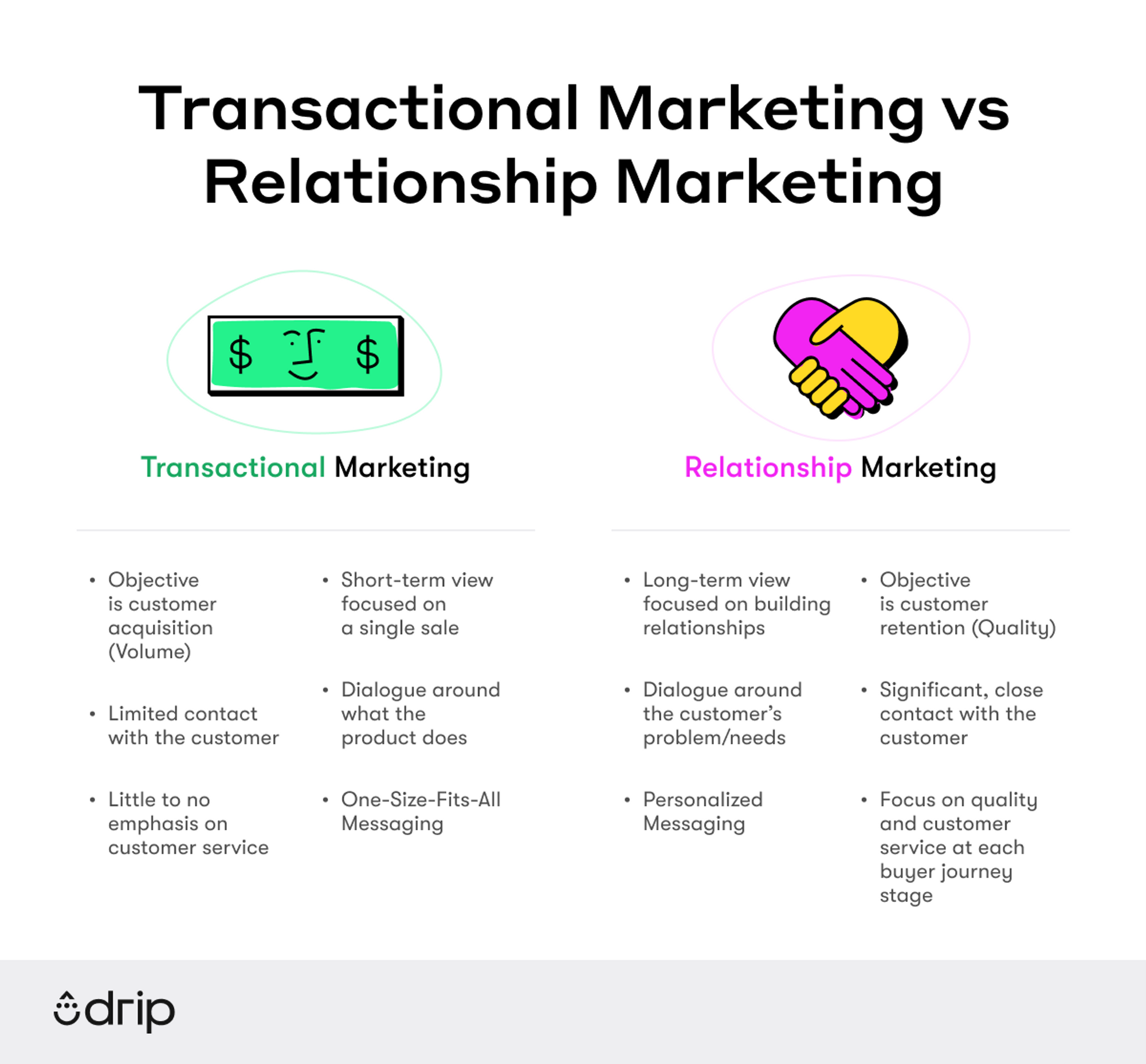 Relationship marketing (or customer relationship marketing) usually starts after the customer has made the first purchase. It's about nurturing an ongoing connection with customers to encourage them to return for more purchases.
Relationship marketing (or customer relationship marketing) usually starts after the customer has made the first purchase. It's about nurturing an ongoing connection with customers to encourage them to return for more purchases.
4 Benefits of Relationship Marketing
Relationship marketing is a strategy that emphasizes creating strong relationships with your customers. Let’s take a closer look at the benefits you can expect from doing that.
1. Increased Customer Loyalty
When customers have a strong emotional connection to your brand, they’ll keep coming back for more. This leads to increased customer loyalty, which can turn into repeat purchases and long-term customer relationships.
The idea is that you don’t want to be the only option.
You want to be the preferred option.
Because while you won’t be able to stop your customers from learning about other brands, you want them to prefer you to your competitors.
American consumers who participated in a study reported that59 percent of them would stay loyal to a brand for life once they become loyal to it.
Ultimately, this means better word-of-mouth referrals for you, plus more recurring purchases from your loyal customers.
2. Improved Retention
Customer retention is essential for businesses, and relationship marketing can help to increase that.
According to the Pareto Principle, 80 percent of your company’s revenue likely comes from just 20 percent of your customers. This means that a recurring, loyal customer generates 16 times more revenue than your one-off customers.
Those loyal customers are your bread and butter.
This is why more and more ecommerce businesses are looking into customer lifetime value — because the more you can increase a customer’s lifetime value with your brand, the more recurring revenue you can generate overall.
Relationship marketing aims to do exactly that.
3. Improved Marketing ROI
A strong customer relationship has a direct impact on your marketing ROI and can help you to get the most out of your marketing efforts. The more connected a customer is to your brand, the more likely they will respond positively to your marketing.
Think about it this way: that first conversion is the hardest in ecommerce.
You have to build much more trust than a traditional brick and mortar shop. Customers can’t touch, feel, or experience your products in the way they can in physical stores.
That first hurdle is especially high.
However, once you jump the first one and earn enough trust for the initial purchase, it will be that much easier to reconvert a customer again — especially if you succeeded in delighting them the first time around.
From there, the majority of the legwork is done, and you need to focus on maintaining that relationship.
4. Improved Customer Insights
When you build strong relationships with your customers, it's much easier to get their feedback on your products or services. This can be invaluable for businesses as it helps to shape product development and customer service.
Loyal customers are your greatest asset. Their opinions of your brand can help you to not only keep them loyal, but also figure out how to transform more of your one-off customers into those same loyal champion customers.
After all, who better to tell you how they became so loyal than your customers themselves?
How to Create a Relationship Marketing Strategy (With Examples)
Creating a relationship marketing strategy is all about understanding who your customers are and what they need. Here are some steps to get you started.
1. Establish an Emotional Connection.
Establishing an emotional connection is the first step in building a relationship with your customers. You can do this by understanding your customer's needs and interests and creating meaningful experiences for them.
What can you offer to your customers that your competitors can't? For instance, it’s a good idea to use personalized messages, images, or stories to make your customers feel like they’re part of something bigger.
A great example of building an emotional connection with your customers is the welcome email from Three Ships.
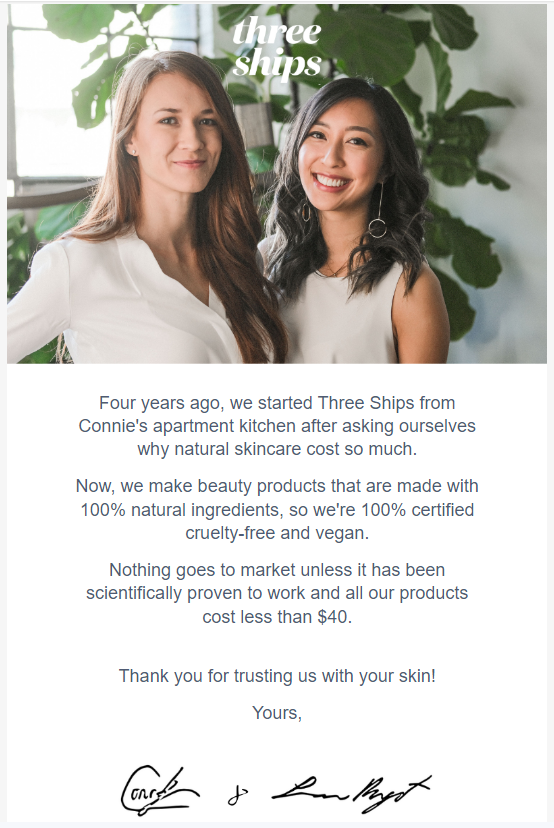 Creating a “we started this business because we’re like you” messaging is a great way to foster trust and loyalty.
Creating a “we started this business because we’re like you” messaging is a great way to foster trust and loyalty.
This helps create an emotional bond between your customers and your business, which will make them more likely to come back.
Immediately, they hook you in by questioning the high price of skincare. They continue and explain how they created skincare products that cost less than $40 but still contain 100% natural ingredients.
This creates an emotional connection with people who value natural ingredients yet don't want to spend a fortune. This appeals to customers who are conscious of the problems that exist in the skincare industry, and want to choose products that align with their values.
Furthermore, the founders' image brings up personality and trust.
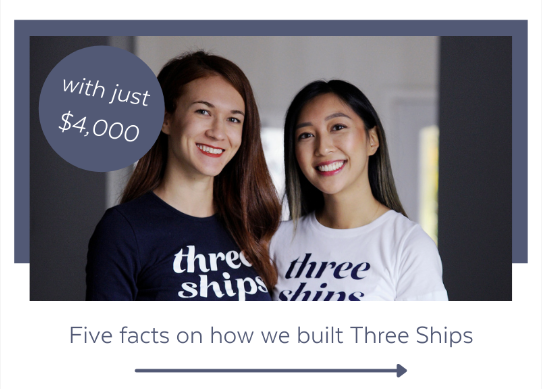 An email like this is a great example of one you can send after the customer makes a purchase for the first time.
An email like this is a great example of one you can send after the customer makes a purchase for the first time.
After this, you could go further by deepening the relationship by sending content with more value, such as skincare tips and advice, or deeper context for the brand and its values.
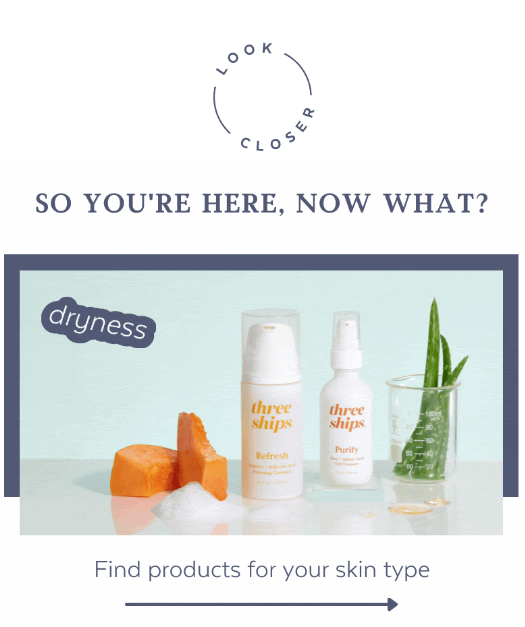
Three Ships does this by offering a way to find products that are personalized to your own unique skin care needs.
So not only do you feel like you’re part of a movement tearing down preconceived notions in skin care, but you can have the perfect product for your personal needs.
2. Making Your Purpose Known
When your customers can clearly see and understand the values you uphold, they are more likely to stay loyal and trustworthy.
For example, if you are a clothing retailer, you might want to focus on the ethical production of your clothes or the environmental sustainability of the materials used.
Or, as in the previous newsletter example, Three Ships' purpose is to create natural skincare products at an affordable price, and they make that clear.
To clarify your company's purpose, these questions can help:
- Why do you do what you do? This helps your customers understand the purpose of your business and how it can help them.
- What do you stand for? Your customers need to know what beliefs and values you stand for. This will make them understand why they should trust your products.
- What makes you unique? This helps to distinguish you from your competitors and set yourself apart.
By clarifying these things, you can create a strong bond with your customers based on shared values.
Baronfig is a design-focused stationery company that clearly states its purpose in the welcome series they send to customers.
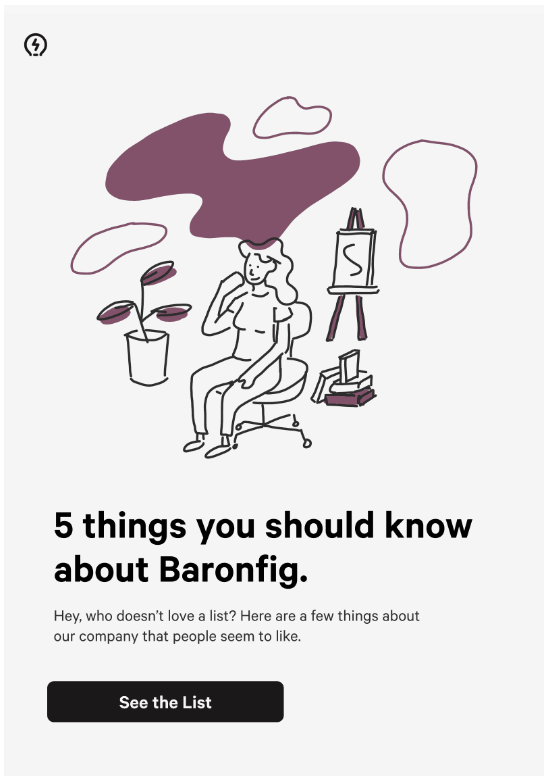
The first link leads to their About Us page, where they explain their mission of inspiring creative thinking. Then, they share how they design their products to do just that.
Not only that, but they make their core values clear by explaining that they are an environmentally conscious company and they want to leave the world better than they found it — by planting a tree for each purchase made.
The email also has two different customer reward campaigns, which increase customer retention rate.
They are both executed well.
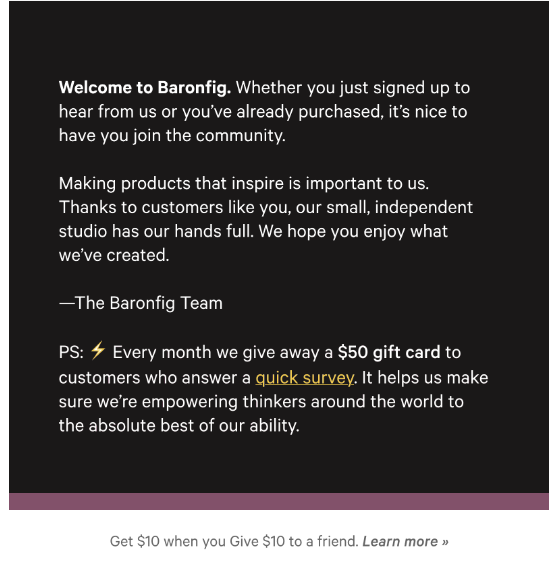 One of them invites you to answer a quick survey, where the company asks you simple questions, like have you purchased previously from them, and what your age is.
One of them invites you to answer a quick survey, where the company asks you simple questions, like have you purchased previously from them, and what your age is.
These may seem just simple questions, but it's important information for Baronfig, as they can use the data to offer their customers better product recommendations.
The other customer reward campaign is "Give $10, Get $10." This campaign helps to invite friends to increase the customer base, increasing customers' loyalty as they get rewarded for their efforts.
3. Prioritizing Retention Through Customer Service
Providing an excellent customer service experience is a must when creating a relationship marketing strategy.
It’s essential to ensure that your customers feel heard and valued at every step of their purchase journey.
Consider working on these things:
- Create different forms of customer service. Live chat, email, phone, and social media are just a few of the many options you can choose from. Self-help options like FAQ pages or video guides can increase retention as well.
- Provide timely responses to customer inquiries. Nothing frustrates customers more than delays in responding to their inquiries.
- Use the right tools. Tools like CRM software can help your team organize customer information and respond swiftly to customer inquiries.
- Make sure customer service is friendly, helpful, and knowledgeable. Your customers need to feel that they are in safe hands when they contact you for help.
- Use a supporting tone to sell rather than a promotional one. Focus the conversation on solving customer problems rather than pushing them to buy a product.
Commonly used by ecommerce stores, North Face utilizes an abandonment cart email campaign to help increase customer retention.
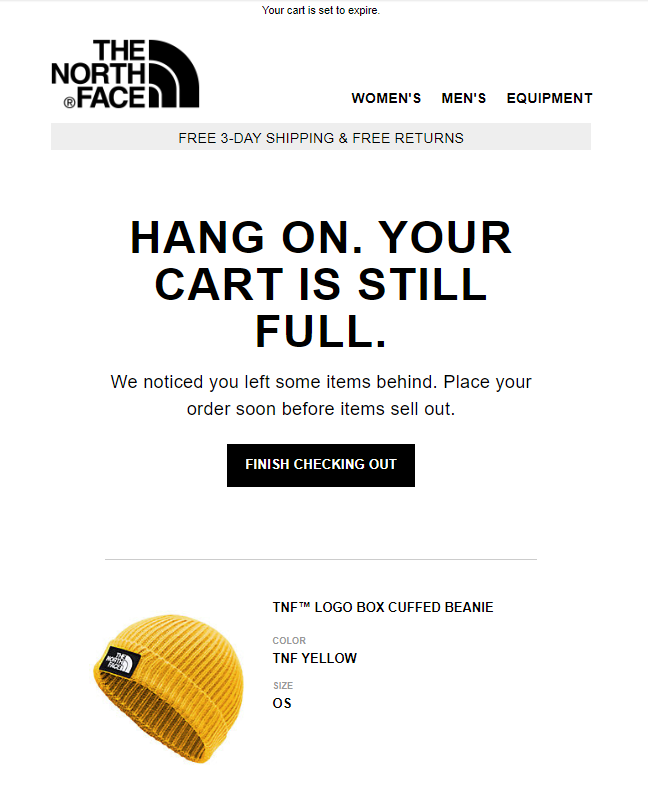 The free 3-day shipping and returns that Northface displays on the email creates additional customer trust.
The free 3-day shipping and returns that Northface displays on the email creates additional customer trust.
On top of that, they use a captivating slogan, "A Lifetime Of Exploration," which guarantees a lifetime warranty against manufacturing defects.This guarantee helps build customer trust to help get them over that finish line.
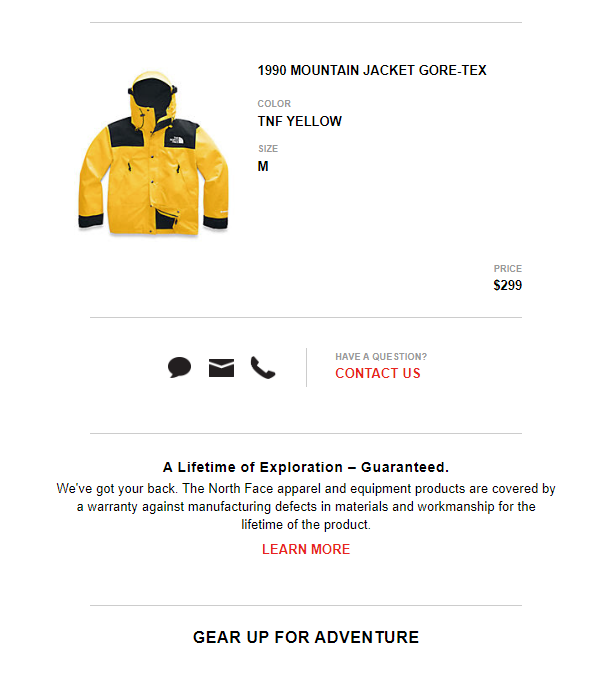
4. Get Feedback from Customers Often
Feedback is crucial for ensuring that your products and services meet the needs of your customers. This will help you identify areas where you could improve, leading to improved customer satisfaction and loyalty.
There are many ways to ask for feedback, including onsite, after the purchase (post-purchase), via social media, emails, and even with SMS.
Be transparent with customers and tell them that you value their feedback. You can show appreciation with discounts, rewards, valuable resources like e-books, or even recognition, like featuring them on your website.
Any feedback is valuable, both positive and negative. It is important to address any issues that customers bring up — positive or negative — to ensure that the current and future customer experience improves.
A great way to measure your customer service is by using the commonly used customer service metric, Net Promoter Score (NPS). NPS surveys measure customer loyalty by asking customers one question:
“How likely are you to recommend this product/service to a friend or colleague?"
An NPS survey is effective because it’s low commitment. It’s not hard to get your customers to answer a single question — and you can always include a box for additional comments for the customers that are particularly motivated.
Myro is doing exactly that. They send out regular surveys to gauge customer satisfaction and use the data gathered to improve their products continuously.
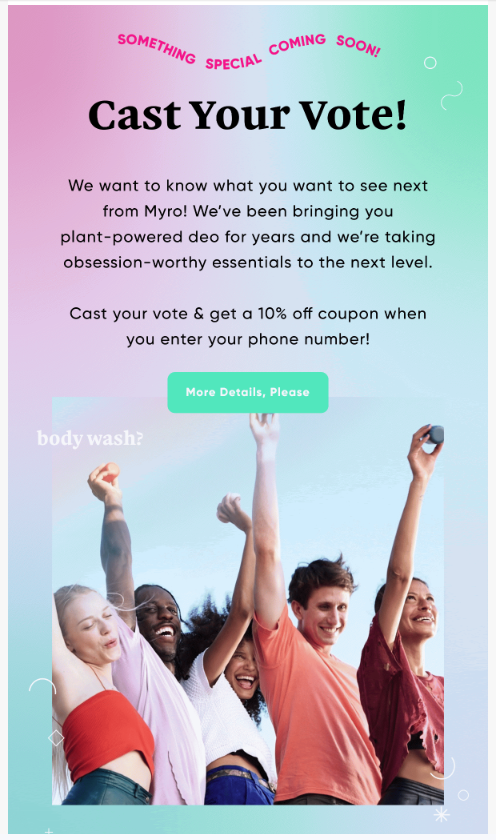
Sometimes a small incentive is all you need to get customer feedback.
To increase feedback, Myro offers a 10% discount to their customers who take the survey.
5. Put Customer Retention At The Center of Your Strategy
Customer retention should be a central part of your relationship marketing strategy. Don’t just focus on acquiring and delighting new customers; also focus on delighting and strengthening the bond with current customers as well.
For each step of the customer journey, create content that feels personalized and speaks directly to your audience.
You don't want to be too broad or too generic.
You should tailor your message to your target audience, and it should make them feel valued.
Make the content consistent across all channels so your customers can easily recognize your brand and its message. Take advantage of customer data such as CRM, purchased data, RFM analysis, and email analytics to personalize your content to the individual customer's needs.
Prose, a personalized hair-care company, focuses on customer retention by creating personal relationships with each of its customers.
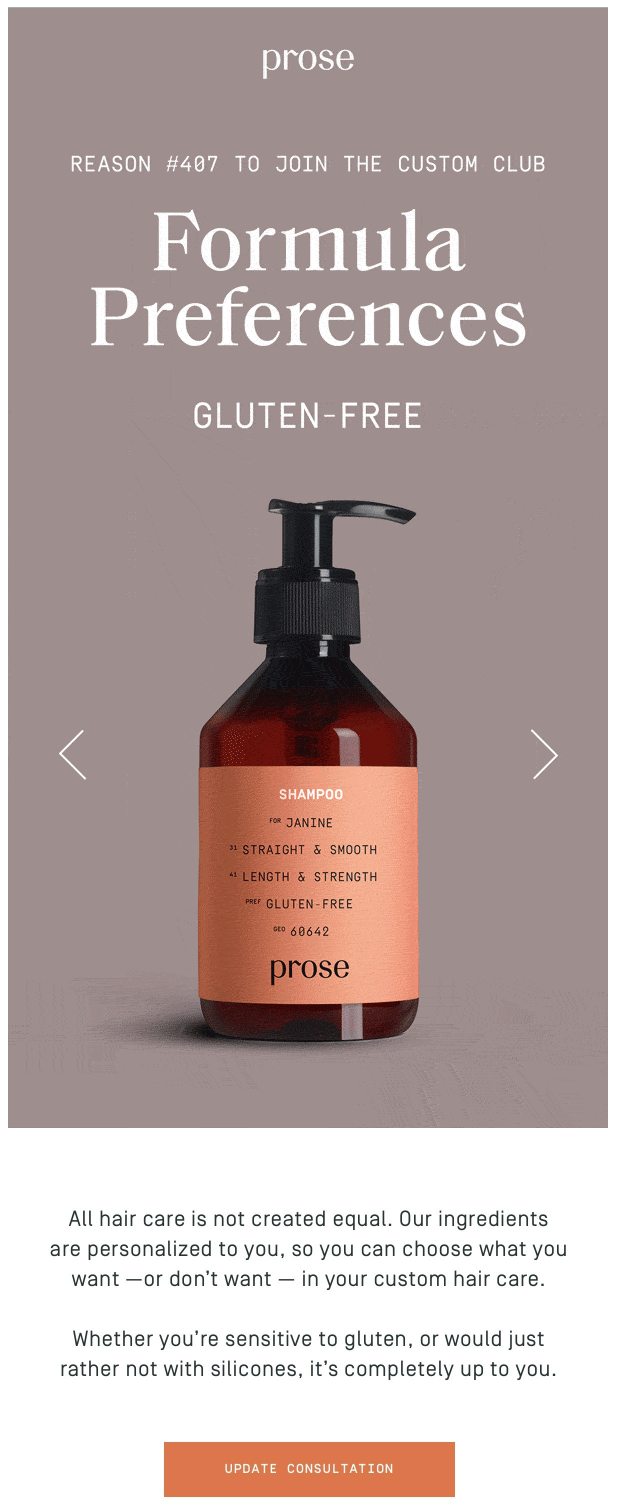
It's hard to ignore the great visual side of the email. What takes over half of the space is the huge GIF visually sliding through the different formula preferences.
The email has relatively minimal text, but what it does have is powerful. The first line, "All hair is not created equal," immediately brings up a massive problem that Prose's customers face.
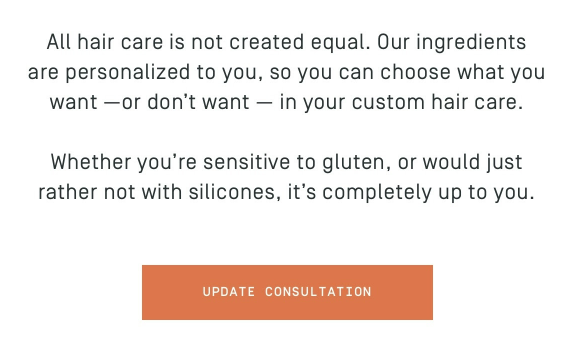
Straight after that, you're provided with a solution (ingredients personalized for you) and a free consultation with one of Prose's experts.
They then follow up with more information about silicones, and why you might care about them.
This angle of personalization plus education shows the customer that Prose cares about what they care about — even if they don’t know they care about it yet.

Something custom made for you feels more special. The way Prose offers customization in their products makes each purchase feel more personal and tailored to their customers — which ultimately strengthens the bond between customer and brand.

Relationship Marketing With Drip
The bottom line is that relationship marketing is key to building long-term relationships with your customers. It requires consistent effort, but the results are worth it.
Invest in customer feedback, invest in personalization, and build trust with your customers.
In the end, relationship marketing is all about providing great experiences for your customers that not only make them happy but also keep them coming back for more.
How can you get started creating and building those strong relationships with your customers?
Start by using your data to identify your best customers, and focus on delighting those customers with a special offer. Drip’s customer data management and advanced segmentation helps you see exactly who your best customers are.
Ready to jump in? Try Drip free for 14 days!


